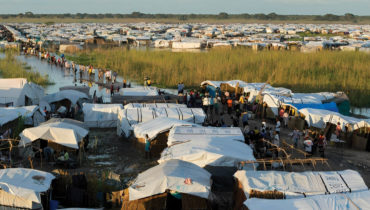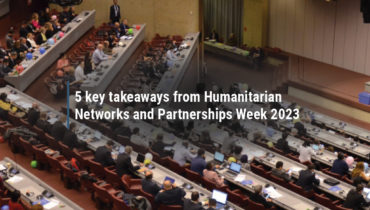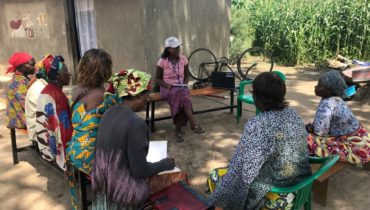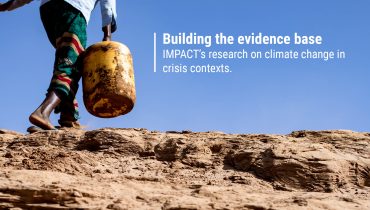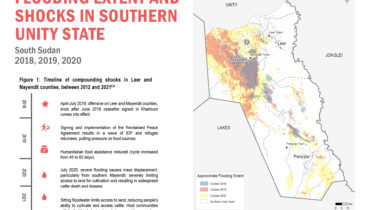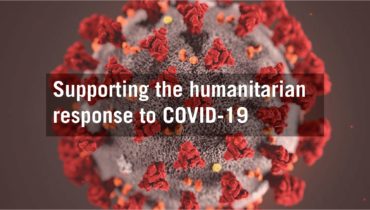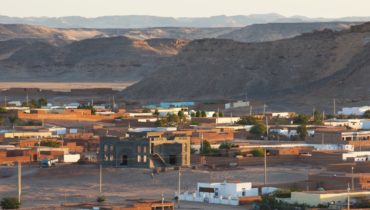South Sudan: 80% of the assessed settlements never or only sometimes felt safe – REACH unpacks the linkages between inter-communal violence and food security in the Eastern Lake States
24 October 2018

A herder drives in a peg to tether cattle for the night in a cattle camp in Payam Mingkaman. Based on REACH findings, Mingkaman saw the bulk of displacement in the Eastern Lakes region from June to September. (© ICRC / Guido GOVONI)
60 percent of the population in South Sudan faced Crisis or worse levels of food security from July to August this year. This was among the main findings of the latest release by IPC, an initiative responsible for consolidating and analysing data on food security. The release gave little hope for the future. Seven states where expected to reach Catastrophe levels of food insecurity by September, and similar levels were projected for several regions for the year to come. Among the populations experiencing and facing severe food-insecurity were communities living in Awerial, Yirol East and Yirol West counties.
REACH has been conducting assessments in hard to reach areas in South Sudan since 2015 and Awerial, Yirol East and Yirol West counties fall in the category of states where humanitarian actors are often faced with challenges in the delivery of aid as well as collecting information. In order to provide timely updates on the conditions in these so called Eastern Lake States, REACH collected and consolidated data from June to September and drafted two situation overviews made public in October and November.
The findings of the overviews echoed the projections of the IPC release, and confirmed a pattern of high levels of food insecurity, violence and displacement. In addition to looking at developments in the course a quarter of the year, the assessed time period covered the lean season, the season when hunger is most severe. Despite the unusually difficult timing, the counties provided an alarming example of how weakened resilience to shocks remains pertinent also after the worst is over.
Communal violence as a cause and effect of food insecurity
According to the findings of the June assessment, violent conflict was cited as the major cause of food insecurity in 40 percent of the assessed settlements. The consistently highlighted type of attacks was recurrent incidents of inter-communal violence.
Based on the assessment findings from June and September, violence between communities was reported as the primary protection concern for both men and women. When it came to secondary concerns, the effects of instability became more nuanced. During both months, settlements reported cattle-raiding as the second most pressing protection concern for men underpinning the risks associated with herding livestock – the most common livelihood activity across all three counties. The economic and cultural value of cows was thus noted to have created a situation in which a trade known as the most critical source of livelihoods is also a factor linked to the causes and effects of violence.

According to the findings of the June assessment, violent conflict was cited as the major cause of food insecurity in 40 percent of the assessed settlements. The impact of violence was reflected on the perception of security across the assessed time span.
Based on the findings by REACH, the second most reported security concern for women was domestic violence followed by sexual violence and harassment.
These findings underpin how the persistence of violence and insecurity has impacted the overall perception of safety in the region. Rather than seeing large-scale fights, inter-communal strifes seen in the counties are characterised as small but regularly occurring episodes of violence. Fear of instability is thus a constant backdrop of everyday life, particularly in county border areas. This fear of violence was also clearly reported in the assessments. From July to September, only 20 percent reported feeling safe in the assessed settlements most of the time. In June, 87 percent of theof the assessed settlements reported never or only sometimes feeling safe. The low levels of perceived safety, coupled with the food security concerns remain a major driver of displacement in Eastern Lakes.
Security is food security
The impact of persistent insecurity was also reflected in agriculture and the resilience of communities to unforeseen changes in, for example, weather patterns. According to the data provide by the World Food Programme, rainfall levels continued to be below long-term averages throughout the lean season which was noted to lead communities to delay planting crops in order to mitigate seeds from drying out. This, combined with the continued lack of rain, subsequently delayed the harvest and caused crop yields to be severely diminished. As the lean season progressed, the lack of rain gained prominence as the main cause for inadequate access to food.

The findings of the REACH assessments highlighted that as the lean season progressed, weather patterns gained prominence over inter-communal violence as the main reason for inadequate access to food.
In addition to inadequate rain, pests continue to cause significant challenges for food production with 20 percent of the settlements reporting pests as drivers of food insecurity. Livestock diseases were also noted to plague the region, with 80 percent of the settlements reporting the occurrence of diseases in September. The combined impact of the factors affecting food security resulted in all the settlements reporting most people eating less than two meals per day from June through September.
Water borne-diseases risk substantial in an already weakened group
In addition to the substantial weakness caused by the lack of food and recurrent raids, REACH noted open defecation to be a considerable health challenge across the three counties. In September, 80 percent of the assessed settlements reported no usage of latrines, mostly due to the lack of facilities. Given that large parts of the population in the region reside near water sources, such as rivers and swamps, the lack of latrines poses a clear risk of contamination.
Even though improved water sources were reported as accessible to 70 percent of the settlements, the reports noted that drinking water was also acquired from natural sources and the use of improved water sources linked to perceived safety. Regional unrests greatly affected the ability and willingness of residents to access improved water points.
Security, weather patterns and availability of aid all add up to food security
The recent work by REACH in Awerial, Yirol East and Yirol West stretching from June to September draw a dim picture of the living conditions populations in the region face. The ongoing violence and political instability have chipped the foundation of livelihood sources and hampered resilience to unforeseen weather patterns in large areas of the country. As noted in an in-depth study conducted by REACH on the narratives and lived memory of famine published earlier this year, vulnerability to famine is a result of a spiralling deterioration of resilience to shocks leading and characterised by zero-sum coping mechanisms.
As laid out in the IPC, the situation seen across South Sudan calls for the levelling up of multi-sectoral humanitarian assistance. Yet, a factor hindering the response to the dire situation is the lack of data. This is a topic REACH will continue to address through providing information on the dynamics seen in the region and evidence on the needs of the local populations.
To learn more, visit South Sudan’s page on the REACH Resource Center and read the situation overviews from June and July-September.


